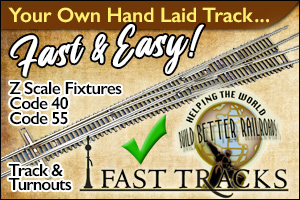Beginning In Z Scale 1:220
The Marklin Company of Germany has been making model trains since the late 1800’s and in 1972 introduced their Z scale model trains to the world. At 1/220 (commonly written as 1:220) the size of real trains, Z scale trains are one of the smallest mass produced trains available. Several of these locomotives measures well under 2 inches in length!
You may have also heard the term Mini-Club used to describe some Z scale products. This is simply an advertising tag used by Marklin to brand their Z scale line which includes trains, buildings, lighting, etc. For the first few years after its introduction nearly all Z scale products were produced solely by Marklin but Z scale has grown well beyond its initial Mini-Club designation.

A Z scale diorama from Ztrains
Marklin led the way with the development of Z scale and in the years since, major manufacturers such as Micro-Trains Line and AZL have joined the party! With a wide selection of locomotives, rolling stock, track and accessories… these two companies are today the principal suppliers of North American Z scale models.
In addition to the major manufacturers we’ve also have seen a minor explosion of high tech small businesses now working either solely in Z scale or including Z scale in their product lineups. Laser cut wood kits, brass etched kits, resin, Hydrocal and injection molding have all become a permanent fixture in Z scale.
What exactly is Z scale? Let’s look at two basic model railroad terms… scale and gauge. While these two terms are often used interchangeably, there is a difference.
Scale: Scale is actually a simple ratio that describes how our model trains compare to trains in the real world. A Z scale locomotive is 1:220 the size of a real locomotive. Compare this to an HO locomotive which is 1:87 the size of a real locomotive. Scale also refers to all the items on our train layouts… houses, trees, cars, etc. If we wanted to accurately model a 30 foot high tree for use on a Z scale layout, we would make that tree 1:220 the size of 30 feet, or 1.636 inches.
Gauge: Gauge represents the distance between the rails on a track. There are essentially two families of railroad gauges, standard and narrow. These gauge classes apply to real railroads (also called prototype, prototypical or 1:1) as well as model railroads. Standard gauge prototype railroads have a distance between their rails of 4 feet, 8.5 inches. Narrow gauge prototype railroads are defined as railroads with a distance between their rails of less than 4 feet, 8.5 inches.
Z scale trains operate on standard gauge track as the distance between the rails in Z scale is an accurate representation of prototype standard gauge track (at 1:220 the size of course). Z scale track is also referred to as 6.5 mm gauge track, as that is the exact distance between our Z scale rails. The concept of the standard track system for railroads was developed in the United Kingdom in 1845. The Gauge Act of 1846, passed by Parliament, cemented the idea. This UK track standard eventually made its way to the US, and is the standard that is still in practice today. You can read more about rail gauge history here.

The B&O diorama using MTL's bridge and locomotive
Why Get Involved In Model Railroading?
Call it a hobby, building a 1:220 scale empire, or just having fun… there’s a lot to be said for model railroading for both the beginner as well as the more advanced modeler. One of the most tangible results of model railroading is the creative stress relief it offers. From high school to retirement age plus, everyday stress affects us all. Working with model trains for many is a terrific stress reliever as it allows you to immerse yourself into a unique world that you create. Your model railroad world can be as simple as a single loop of track that runs like a fine watch, or as intricate as a bustling 1950s switching yard by the harbor… it’s all up to you.
Why Choose Z Scale Model Railroading?
One of the more unique features of working in Z scale is duality of the size. On one hand you can have an interesting layout in a very modest space. On the other hand you can model incredibly vast scale scenes in a medium to large space. To put in into better perspective, look at what has classically been a beginner’s size layout in HO scale, a 4′ x 8′ sheet of plywood. In Z scale this would equal 1′ 6″ x 3′ 2″. You can have the exact same track plan, trains, buildings and scenery in a fraction of the space.
Of course if you want to have a larger layout here is another real and still being discovered strength of Z scale. You can build broad, open stretches of land featuring multiple track lines that will easily accommodate several dozen cars. Create neighboring towns and industrial areas that are not built on top of each other but instead are allowed to sprawl out around the edges as they do in real life. Let your mountain ranges… be mountain ranges! From portable briefcase layouts to truly expansive modular and permanent layouts, Z scale model railroading is unique in its ability to adapt to your needs.
Category: Introduction To Z Scale















